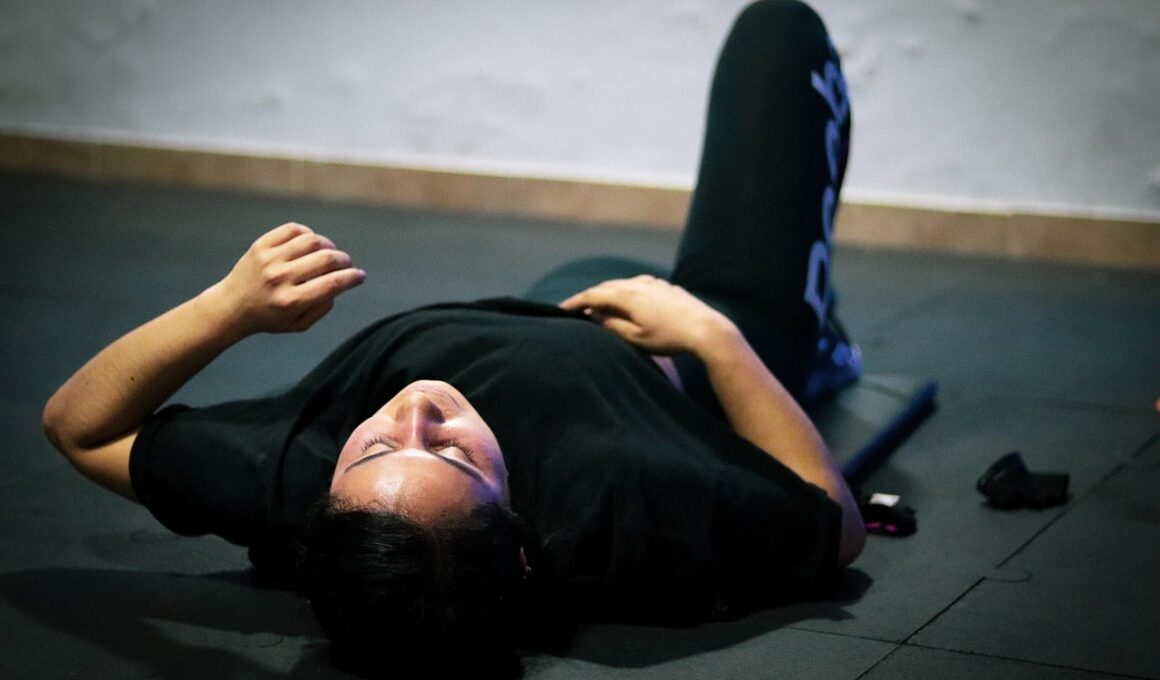HIIT-Based Core Circuits to Improve Balance and Posture
Incorporating HIIT-based core circuits into your fitness routine can significantly enhance your overall balance and posture. These circuits focus on progressive strength-building exercises designed to engage and stabilize the core muscles. A strong core not only contributes to better posture but also increases overall athletic performance. The term “HIIT” refers to High-Intensity Interval Training, where you alternate between intense bursts of activity and fixed periods of less-intense activity or rest. This training method emphasizes the need for high energy and strength output over short periods. Including circuits that emphasize core engagement, such as planks, mountain climbers, and Russian twists, can lead to improved muscle endurance and stability. It’s crucial to create a well-rounded HIIT circuit emphasizing different core muscle groups while keeping the intensity high to maximize benefits. Integrating these movements both reduces the risk of injury and enhances overall functional strength. Consistent practice supports muscle memory and can lead to visible results within a few weeks. HIIT workouts can be tailored to any fitness level, making them accessible and easy to incorporate into any schedule.
To effectively implement HIIT-based core circuits into your training schedule, start with a balanced warm-up. The warm-up is essential as it prepares the body for the physical demands of the workout. After warming up, choose a mix of core-focused exercises that challenge your strength while promoting stability. Each exercise should target different core areas, such as the rectus abdominis, obliques, and deep core stabilizers. A sample circuit might include intervals of plank holds, bicycle crunches, and side planks for 30 seconds of effort followed by 15 seconds of rest. Rest intervals serve as recovery to enhance performance in subsequent sets. As your strength develops, progressively increase the duration and intensity of your intervals. Your body will adapt over time, requiring you to continually challenge yourself with new heights. Ensuring that you maintain proper form throughout is vital to prevent injury and achieve the desired results effectively. Additionally, engaging your core muscles deliberately during exercises amplifies the benefits of your workout. It’s crucial to maintain consistency and dedication to see significant improvements in balance, core strength, and posture.
Key Exercises for Core Strengthening
When focusing on HIIT-based core circuits, certain key exercises stand out due to their effectiveness in strengthening the core. Planks are one of the best exercises that engage multiple core muscles simultaneously. They promote stability and endurance, both necessities for excellent posture. Other effective movements to incorporate into your routines include the medicine ball slam, which provides explosive power while requiring core engagement. Spiderman planks can also be added to challenge not only the core but also the shoulders and legs. These add complexity and enhance your overall workout. Incorporating added resistance can also amplify the intensity of your circuits. Using weights such as kettlebells or sandbags during exercises like deadlifts can yield greater muscle activation. Remember to include rotational elements such as woodchoppers that enable you to work on rotational strength too. Additionally, targeting different planes of motion aids symmetry in muscle development, translating to a more balanced posture and functional performance. Ensuring variety in your routine can keep you motivated and engaged while maximizing the benefits of your workouts.
In addition to performing core circuits, integrating certain lifestyle changes can further enhance balance and posture improvements. Focus on body awareness and engage in mindful movement throughout your daily activities. Incorporating practices such as yoga or Pilates can significantly improve flexibility and core strength. Activities like these emphasize maintaining proper alignment, increasing body awareness, and enhancing muscular endurance. Furthermore, being conscious of your sitting and standing posture can stimulate the development of strength. Sitting for prolonged periods may weaken core muscles, whereas actively engaging in core exercises will help combat this. When sitting, ensure that your feet are grounded and your back is straight to promote better spinal alignment. Regular breaks during seated work can also help alleviate stiffness and promote blood circulation. Avoiding excessively slouched positions while standing is equally important for maintaining a healthy posture. By combining HIIT workouts with these lifestyle practices, you can achieve more profound results over time. A consistent approach to integrating core workouts and awareness in daily life is vital to achieving fitness goals aimed at improving balance and posture.
Tracking Your Progress
Monitoring your advancement in strength and balance is essential for maintaining motivation and adjusting your training regime effectively. Consider keeping a workout journal or using fitness apps to log your exercises, repetitions, and duration of circuits. This tracking can help you identify patterns and areas that require additional focus. Regular assessments of your core strength are also essential. Simple tests, such as timed plank holds or stability ball exercises, can serve to illustrate improvements and offer insight into your progress over time. Celebrate your milestones, however small, to reinforce positive motivation. Progress photos can also visually highlight the changes in your physique, further inspiring your commitment. In addition, implement regular evaluations of your balance through exercises that require stability. Activities such as single-leg stands can serve as benchmarks for improvement. Having benchmarks allows you to measure the progress and effectiveness of your HIIT-based core workouts. Establishing short and long-term goals can provide a clear roadmap to achieving your fitness aspirations, fostering dedication and resilience as you work toward a stronger core that supports better posture.
Nutrition plays a critical role in optimizing the results from any workout regime, including HIIT-based core circuits. To fuel your body efficiently, focus on a balanced intake of nutrients that support energy and muscle recovery. A diet rich in lean proteins, healthy fats, and plenty of fruits and vegetables can provide the necessary sustenance for intense workouts. Protein-rich foods such as chicken, fish, legumes, and nuts are vital for muscle repair and growth. Additionally, staying well-hydrated is crucial, especially during high-intensity workouts. Adequate hydration ensures that your body functions optimally and reduces the risks of injury related to dehydration. Consider creating pre-and post-workout nutrition plans to sustain your performance. A small snack composed of carbohydrates and protein before your workout may enhance your energy levels. Alternatively, a protein shake after your routine can aid recovery. Furthermore, being mindful of portion sizes can also lead to a balanced caloric intake. Ultimately, aligning your nutrition with your fitness goals is essential to fully realize the benefits of your HIIT-based core circuits and improve your balance and posture.
Creating a Sustainable Routine
Establishing a sustainable routine grounded in HIIT-based core circuits can enhance overall fitness and performance. Yet, it’s essential to listen to your body to prevent burnout. Start small if you are new to core workouts or HIIT, gradually increasing the intensity as you adapt. Consistency is the key to success, so aim for two to three HIIT sessions weekly, coupled with recovery and flexibility work. Setting up a schedule can foster a level of accountability that keeps you on track. Build a workout plan that allows flexibility for different types of movements and ensures your body remains engaged. Mixing in lower-intensity exercises within your week prevents fatigue and promotes recovery while still challenging your core. Additionally, consider joining group classes or finding a workout buddy to make the experience enjoyable. Exchanging support may offer extra motivation and social interaction as well. Establishing a routine that incorporates a variety of workouts and adequate recovery times will enhance your progress while reducing the risk of injury. Hence, staying committed enables continuous improvement and success in boosting core strength, balance, and posture.
Finally, understanding that improvement and progress are gradual processes is vital. Embrace the journey rather than solely focusing on the end results, as this fosters a more enjoyable experience. Each individual’s progress will vary based on personal fitness levels, lifestyle, and dedication to the programs. Setting realistic goals can help manage expectations while instilling a sense of accomplishment. Remember to utilize available resources, such as online workouts and community support, to augment your learning and motivation. Whether through instructional videos or fitness forums, plenty of information exist to help refine your training techniques. Also, be open to adjustments as you learn what works best for you. Adapting your approach to incorporate new exercises keeps routines fresh and engaging. Explore aspects of fitness that resonate with your personal interests, and you may find greater inspiration to adhere to your regimen. The balance sought in your fitness journey also fosters the development of lifelong exercise habits. The core strengthening journey through HIIT circuits not only benefits posture and balance but also reinforces a healthier lifestyle and mental well-being.


